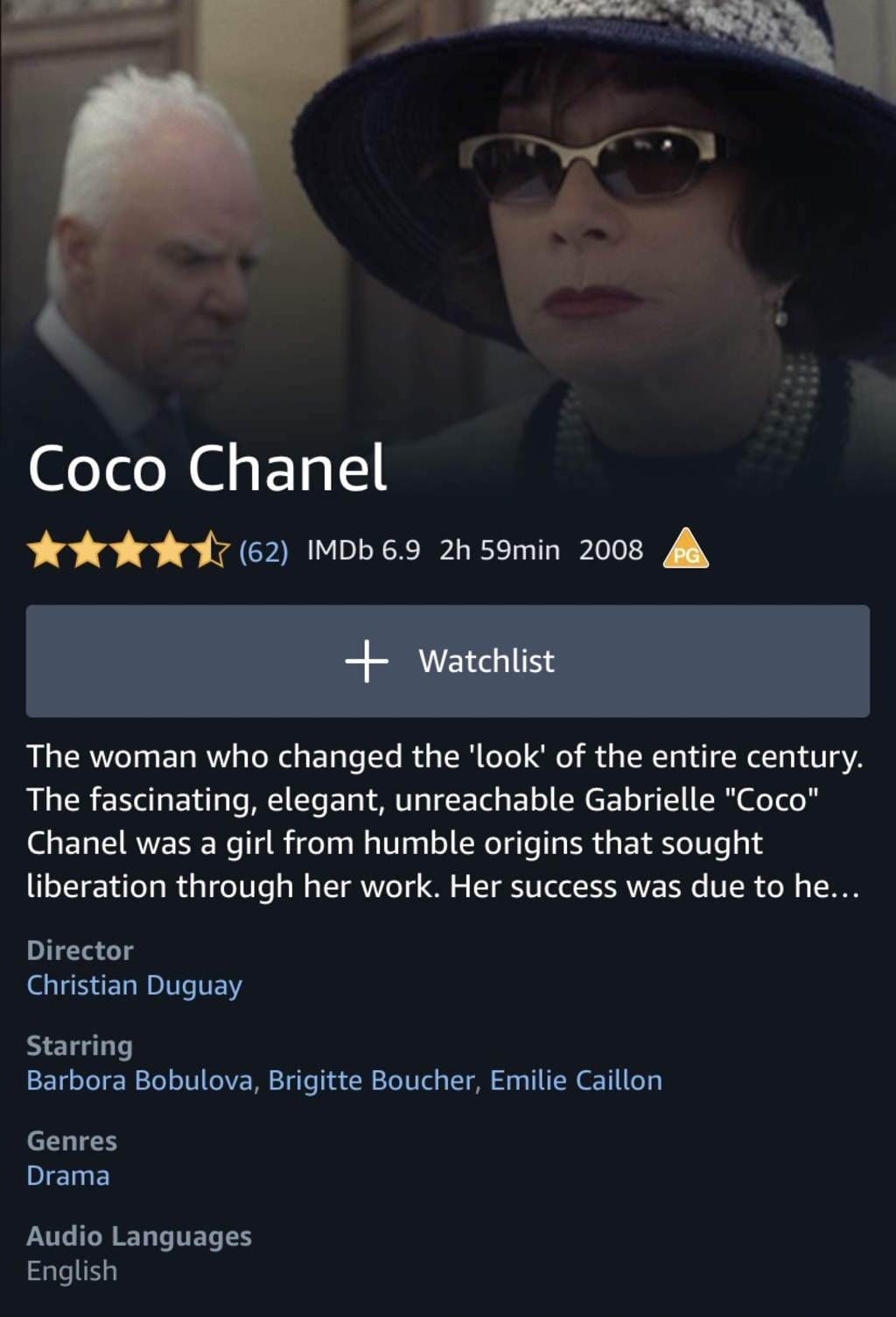
The scene is set. Our preconceptions about Madame Chanel looming over us, the audience. Will she be like I imagine? We all know the iconic Chanel look. The tweed suit, the rows of pearls, but little is known in common knowledge of how she got to that point. Gabrielle Chanel was not born into wealth, rather extreme poverty and abuse. Despite this, a young Gabrielle fearlessly believed in the innate goodness of her father, something we realise on reflection kickstarted her relationship with protective figures.
The scene is set when Gabrielle is dropped off at Auberzine, a convent in the South of France by her loving father. He leaves a young Gabrielle with her sister, radiating warmth and that this is a temporary situation. The positioning of the father in the opening scenes implies his innocence and lack of fault for this to take place, where in fact he was the sole reason for their misfortune. This piece of narrative is also incorrect. Gabrielle’s father was absent for most of her life, especially the years depicted in the start of the film. Through reading countless research papers, biographies and articles around Chanel (bibliography to be found at the bottom), it is clear that Gabrielle ended up living with her Aunties after her mother died and Father deserted the family (chasing tail, may I add), meaning her father physically couldn’t of been the one to drop them off at the convent. It also shows Gabrielle with her sister. This is also incorrect. Gabrielle was with her cousin, Adrienne who later married Ettien Balsan. Gabrielles sister either remained in their small mountain town, or died shortly after their mothers passing. The film also shows Gabrielle making routine visits back to Auberzine to see her ‘sister’, which we know to also be incorrect. This cinematic exaggeration was probably to position Gabrielle as a bigger empath than she was, bringing her feminine humility to the forefront so both male and female audiences position her still as ‘woman’.
The film continues and we see the evolution of a young Gabrielle, on her 18th Birthday she is asked to leave the convent and make her own way in the world. Orphaned and abandoned by everyone who’s ever loved her, Coco (2008) shows Gabrielle making her way to a seamstresses store, kick starting her love affair with fashion. Gabrielle had been making her own clothes since a very young age, yet her personal style was much simpler than the fashions of the time. Many ladies would adorn great, feathered hats, an overt symbol of wealth & class. Gabrielle did not. Her simple take was intentional through style and by her lack of finances. She decided to use her status consciously and combined her dark, dry sense of humour with an innate dream of what her life could look like. At this point, Gabrielle believed her life was destined for the stage, taking us to the next inaccuracy.
Coco (2008) depicts military officers thrusting a young Gabrielle on stage at what we can assume to be Moulins, she is obviously reluctant to preform and the misé-en-scene casts Gabrielle in a small light. This is BULLSHIT! Gabrielle had been dreaming of a life on stage/as an actress for the riches since she was tiny. This is very well documented in early corespondents and diaries. Any opportunity to preform, no matter how daunting, wouldn’t of been met with reluctance. Coco fell into fashion but she pined for the stage. Objectified by the male gaze, Coco (2008) shows Gabrielle being ‘saved’ by her ‘hero’ Balsan (who later marries her cousin), bringing her flowers and rescuing her from the lowly job of seam-stressing. Whilst we know this to be accurate, Gabrielles portrayal in this section further depicts her as an object of the male desire rather than a person in her own right. Perhaps this was intentional, but I think not.
Furthermore, in the carridge ride from the store where Gabrielle was working near Moulins (also incorrect timeline but we’ll let it slide), Balsan mentions how he cant wait to introduce Gabrielle to his parents. His parents actually died before meeting Coco, so this is also historically inacurate.
Balsan especially liked Gabrielle for her no-nonsense, somewhat lack of ‘girlyness’ but elegance. The actress currently playing Gabrielle in this section does not have the gusto you would expect, from research, Coco to have. She seems almost serventile and submissive, with very few flashes of the backbone we know Gabrielle to have from a young age. Side note, Balsan looks more like Boy Capel (Gabrielles one true love) than himself from photos.
After this, Adrienne played the role of someone who did not support Gabrielles choice to move in with Balsan. Actually, it was Adrienne who most dreamed of marriage and first got engaged to Balsans brother(?) after meeting during Adrienne and Coco’s double act at Moulins. Adrienne and Gabrielle most likely worked as courtesans to pay their way, as despite the lack of charm, neither vocals were destined for greatness. Coco dreamed of independence and riches yes, and was ultimately using Balsan and following Adrienne’s lead, making this next scene also fairly unbelievable.
Contrasting ‘Coco’ (2008) with the ‘Coco before Chanel’ film and Balsan is portrayed in completely opposite ways. This is important as it shows the differing points of view between male directors and ‘herstory’. In Coco Chanel, he is romantic, attentive, passionate and chasing Gabrielle and Gabrielle alone. Inviting her to dinners and dancing with his circle. In Coco before Chanel, he is quite cold, calculated and using. Almost simple, just a wealthy orphan wanting a friend and using his assets to leverage it so. He never wanted Coco to stay longer than a few days, made her dine with the maids and hid her from his circle. The real truth is perhaps somewhere between the two, with Balsan being calculated but somewhat romantic, due to his love for women and sex in general. I say women rather than Gabrielle, because of his many recorded affairs and house guests around the same time as Gabrielles stay at his castle.
After a strange meeting with Boy Capel in Coco (2008) (the two actors should have been switched btw), Balsan gifts a fairly young Coco a string of real pearls, with a diamond encrusted fascinator, looking similar to the Camelia rose. This is important because the Camellia later became a famous signifier for Chanel, commonly used in early designs and still implementing in packaging and branding to this day in 2020. Implying the idea was first planted by a gift from Balsan is almost insulting to Gabrielle and Arthur Capel’s romance in real lice, because it suggests he not only held a significant place in her heart (insulting), but that Balsan almost ‘defined’ her look by gifting the string of pearls, Coco’s most note-worthy staple piece. People who have researched Gabrielle will know that her pearls were actually fake, as she considered women adored in riches/flaunting wealth like that to be tacky and unelegant. Furthermore, it is uncertain when Gabrielle first started wearing the iconic strand of pearls, but it was almost certainly later than this point in time. In this film, she hadn’t even readapted her horse-riding dress to menswear, or had any interaction at all with hats. If the pearls were a symbolic storyline kickstarter for Coco discovering her independence (we discover the pearls were actually gifted to every woman Balsan entertained and Gabrielle could not keep them), she turned away from the adornments he gifted her and developed a ‘fire’ on screen. This fire has definitely been there since Moulins. The insult is that on screen, it looks that this fire was a reaction to Balsan, not innately Gabrielle.
It is also interesting to note that observing similar situations in different Chanel documentaries, weird storylines and character developments appear.
In Coco (2008), an Old Coco is shown working in workroom asking “should we do the skirt above the knee, or below the knee?”... whereas in ‘Coco before Chanel’ at the same point in time, old Coco would proudly proclaim “i hate skirts above the knee! I hate xyz!” with a firm affirmation her taste is the only one that matters.
So. Many. Inaccuracies. In timeline, in stylistic choices, period things like smoking, family inaccuracies, parts of her life missed out (moulins/cabaret), Arthur (boy) Capel ‘saving her’ emotionally and financing the Chanel hat label in the very early days. Instead, Boy Capel, Gabrielles one true love and saviour is ‘embarrassed by her around friends’ and acting like a player. THIS IS FALSE INFORMATION. Despite Capel marrying an Englishwoman of wealth, Gabrielle was never subject to his games and documentation shows his pure love for her. The real Coco, (unlike Balsan).
Also that whole shit with Adrienne in Duville? Srsly? She went with Boy Capel, god damnit!! Where were the famous friends? Then boy just comes in out of nowhere doing the tango? The actual FUCK. In Coco (2008) there are many South American references associated with Boy Capel, but this are also incorrect because Capel was from LANCASHIRE. In today’s world he basically did a Gap Year in Argentina and this film is like ‘omg he’s so latino’ lets cast an Argentinian actor, like what the FUCK man.
In addition, please can we talk about the discovery of No. 5? Just walking into 31 Rue Cambon (which now has the iconic mirrors.. pretty sure they didn’t arrive until year later), meeting a perfumer with a box of samples and picking one at random.. “No 5! Chanel No 5 is what we’ll call it” proclaims Coco in the 2008 film. Bitch no! The initial development process of that fragrance was HUGE and took YEARS. She had to negotiate so much to get to this point, this scene is very misleading and discredits her proficiency as a visionary and business woman.
Note, Gabrielle is now wearing a thin strand of pearls- yet there is no mention if they are real or fake and we are 2:33:40 seconds in.
Lines later on such as “I have a terrible personality” are also signs of laziness from writers. Rather than portraying her personality in the majority of the movie, they tried to condensed a large proportion of who Coco was into one line.
The whole situation leading up to Boy Capel’s death was also insulting to his memory, as was the token of the immaculate white scarf left at the roadside. Simply tacky writing. Moving onto the discovery of the ‘CC’ logo, Coco is shown doodling carefree on tracing paper, flipping one C over the other and ey-voilet! IRL, it was most likely inspired by, if not directly taken from a insignia on a trophy belonging to Boy Capel that Gabrielle was given after his death. The polo trophy had a row of interlocking C’s. Other theories are it simply stands for ‘Capel Chanel’, linking and together forever. After all, Capels money, facilitating property and ‘endorsements’ within the upper classes of Paris so to speak, is what catapulted Gabrielle to new bounds. Capel always believed in Gabrielles visions to work, which was not the norm for women in society at the time, and was a influential steakholder in Chanel since since day 1.
In conclusion, don’t watch this film if you are wanting a relaxing watch - especially if, like me, accuracy is important. This film perpetuates a false narrative of 20th century history, and belittles the actual life and romances of the incredible Gabrielle Chanel. PS: there is zero mention of Igor Stravingsky at all, nor any of Gabrielle’s many important female friendships which helped propel Chanel into the zeitgeist.
Peace ✌🏼





Comments
There are no comments for this story
Be the first to respond and start the conversation.